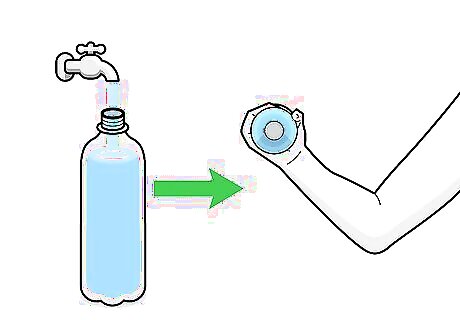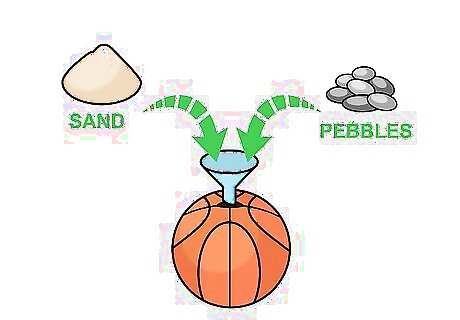
views
Making Kettlebells

Use a milk jug. Fill a clean, plastic gallon jug with water, sand, rocks, or concrete. Make sure that the jug has a handle; you will use this to complete your exercise reps. Use the handles to lift and lower the jug like you would any hand weight or dumbbell. For reference, a 32 fl oz (950 mL) jug of liquid weighs about 2 lb (0.91 kg). Workout tip: With milk jug weights (and other kettlebells), you can do bicep curls, tricep exercises, bent-over rows, pec flyes, deadlifts, and shoulder raises. Workout tip: Fitness trainer Laila Ajani suggests holding these weights at your sides when you’re doing squats or lunges.

Use full paint cans as kettlebells. Hold paint cans in your hands by their handles. Most paint cans are a little heavier than plastic bottles or cans of food, so you can use them as you build muscle. The handles allow you to use the cans like dumbbells. If you need more comfort or grip, add duct tape to the handles, or duct tape a spare rag around the handles. Most full paint cans weight about 7–12 lb (3.2–5.4 kg)

Fill a 5 gallon (18.9 L) bucket with rocks or sand. You might also use water, or even mix, pour, and set concrete inside the bucket for a really heavy weight. Use it to do dumbbell curls, or duct tape 2 of them to a bar or sturdy rod and use them as a barbell for a bench press. Just be sure to have a spotter!

Make a kettlebell out of a potato sack. Grab a potato, rice, or sugar shipping sack, which can be found at most grocery stores. Fill the sack with sand until you have reached the desired weight. At the top of the sack, tie a loop for your hand. Use rope or duct tape to secure the loop so it doesn't detach. If you like, reinforce the sides and bottom of the bag with duct tape. Use a scale to measure out your desired weight before tying the top of the sack.
Making Dumbbells & Hand Weights

Use canned goods as small hand weights. Canned goods that fit into your hands work well as simple 1–5 lb (0.45–2.27 kg) hand weights. This is especially good if you are starting out and trying to build muscles slowly. Use larger canned goods as heavier weights or medicine balls. Workout tip: Hold a can in either hand, and at either side of your head, then slowly raise and lower them 10-20 times for a quick arm workout. Heavy, compact books or virtually any other grippable, heavy item also work well as free weights.

Fill old plastic water bottles with sand or pebbles. Instead of recycling your plastic water and soda bottles, refill them with water, or put pebbles or sand in them instead. When filling them, make sure to weigh them so the weights are the same for both hands. Lift the bottles like you would any dumbbell, using them for bicep curls or tricep extensions. Tie the bottles around your arms or wrists with rope, bungee cords, or any other strap to make improvised no-grip arm weights.

Use packets of rice or beans as free weights. These packages are great for mini-weights if you’re a beginner. Use them right from the cabinet for bicep curls and other small weight-lifting moves. Large bags of rice can also be used as substitutes for medicine balls.

Cut and fill bicycle tire tubes with sand to make hand weights. Take an old bicycle inner tube and cut it into equal lengths. Secure one end of the tube with duct tape, then fill the tube with sand. Close the other end with duct tape. Either leave them flat or bend them into circles until the two ends are touching and secure the ends together with duct tape for an easier grip. This is a great method for making weights of different sizes. Start with 1 or 3 pounds. You can also try 5 or even 8 pound weights. Use a scale to weight out the weights before you close them.

Fill a basketball with sand to make a medicine ball. Take an old basketball and drill a hole big enough to fit a funnel into one of the black stripes. Place a funnel into the hole and fill with sand or pebbles until you have achieved the desired weight. Use a bike tire patch kit to fill the hole, or just cover it with duct tape. The repurposed ball can now be used just like a medicine ball. Workout tip: Perform a quick core exercise by standing with your feet wide, and hold the basketball on the ground between them. By just bending your waist, slowly lift the ball over your head, then back down 5-10 times.

Make wrist weights from socks and beans. Fill a clean sock with dry rice or beans. Alternatively, use pebbles or small rocks for a heavier weight. Sew or duct tape the open end of the sock closed, then sew or tape the ends together to make a looped weight, or sew Velcro onto the ends so you can remove it easily. Weigh the socks on a scale before you sew them closed to get the exact weight you want. When choosing a sock, make sure to choose one long enough to wrap around your wrist. If it’s too long, fill it until it will wrap around your wrist, then cut the excess fabric before closing the end.
Making Barbells & Heavier Weights

Make a barbell with packs of water bottles. Duct tape 6 filled water bottles together, then duct tape the bundle to the end of a sturdy bar or rod. Duct tape another bundle to the other end to make a DIY barbell. Adjust the weight by adding more bottles, or by using fewer. Don’t be shy with the duct tape. In order to make a sturdy bar set, you’ll have to secure the bottles with 3-4 layers of tape. Or, simply secure 2 liquid-filled milk jugs to either end of the bar.

Flip old tired for a classic DIY workout. Tires are used in many workout and bodybuilding routines, like CrossFit. Most commonly, bodybuilders use their legs, back, and arms to lift and flip a tire that’s lying prone on the ground. Or, tie a rope to a tire and drag it behind you as you walk or run for a full-body workout. Visit a junkyard and look for old tractor tires for a real heavy-duty weight set.

Fill the pockets of a fishing vest to make a weighted vest. Get an old fishing vest or a vest with many small pockets, then fill plastic bags with sand or concrete and place them in all the pockets. Run, do pull ups, push ups, or go walking while wearing the weighted vest. Wearing a weighted vest while exercising helps to increase your stamina, endurance, and overall body strength, and can even reduce the risk of falling in old age.

Build a slosh tube with ABS pipe. Slosh tubes are long plastic tubes filled mostly with water that bodybuilders carry on their shoulders to enhance core strength. Put a cap on the end of an ABS pipe that’s about 4 inches (10 cm) in diameter and 9–10 feet (2.7–3.0 m) long with water, leaving about a foot of free space. Then cap the other end and voila! A DIY slosh pipe. Before you cap it, line the threads of the cap with some ABS glue. Then, screw the cap on and let it dry for 5-10 hours before use. Avoid using PVC, as PVC degrades in the sun and can break more easily than ABS if dropped. Use this same method but with smaller tubes to make smaller hand weights.

Fill a duffle with sand to make a sandbag. Sandbags are similar to slosh tubes in that they’re unstable, shifting weights that require you to engage more muscles. To make an easy sandbag, fill 5 or 6 gallon (18.9 or 22.7 L) doubled-up freezer bags with sand, then duct tape them closed. Place the bags into the duffle bag, zip it up, and work up a sweat! Weigh your duffle and aim for it to be around 69 pounds (31 kg), which is fairly standard for a sandbag, or tailor it to your weight preference. Or, fill an old army/navy rucksack or canvas laundry bag with pea gravel until it’s your desired weight. First line the bag with a heavy-duty trash bag to prevent spills.

















Comments
0 comment